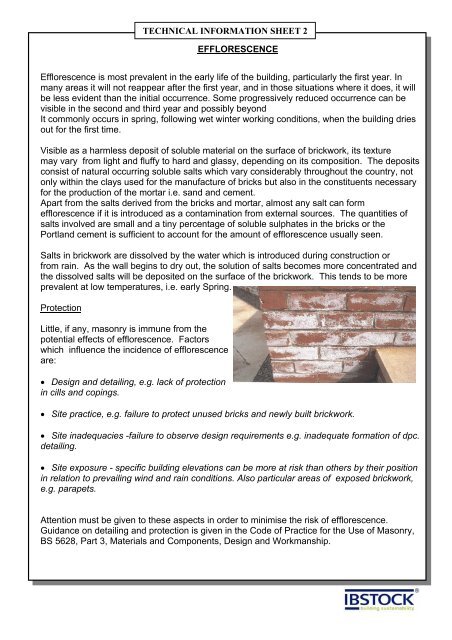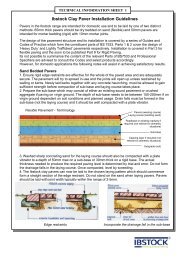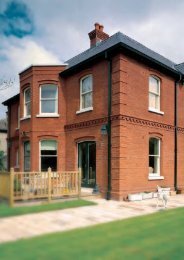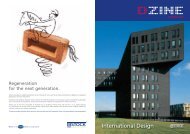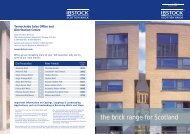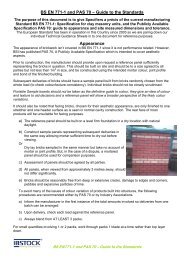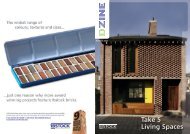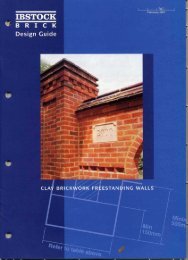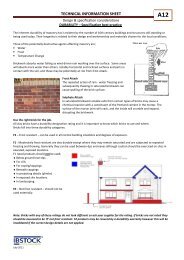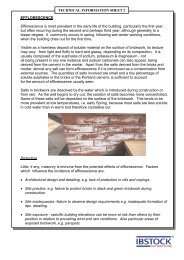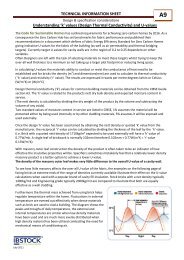2. Efflorescence - Ibstock
2. Efflorescence - Ibstock
2. Efflorescence - Ibstock
Create successful ePaper yourself
Turn your PDF publications into a flip-book with our unique Google optimized e-Paper software.
TECHNICAL INFORMATION SHEET 2<br />
EFFLORESCENCE<br />
<strong>Efflorescence</strong> is most prevalent in the early life of the building, particularly the first year. In<br />
many areas it will not reappear after the first year, and in those situations where it does, it will<br />
be less evident than the initial occurrence. Some progressively reduced occurrence can be<br />
visible in the second and third year and possibly beyond<br />
It commonly occurs in spring, following wet winter working conditions, when the building dries<br />
out for the first time.<br />
Visible as a harmless deposit of soluble material on the surface of brickwork, its texture<br />
may vary from light and fluffy to hard and glassy, depending on its composition. The deposits<br />
consist of natural occurring soluble salts which vary considerably throughout the country, not<br />
only within the clays used for the manufacture of bricks but also in the constituents necessary<br />
for the production of the mortar i.e. sand and cement.<br />
Apart from the salts derived from the bricks and mortar, almost any salt can form<br />
efflorescence if it is introduced as a contamination from external sources. The quantities of<br />
salts involved are small and a tiny percentage of soluble sulphates in the bricks or the<br />
Portland cement is sufficient to account for the amount of efflorescence usually seen.<br />
Salts in brickwork are dissolved by the water which is introduced during construction or<br />
from rain. As the wall begins to dry out, the solution of salts becomes more concentrated and<br />
the dissolved salts will be deposited on the surface of the brickwork. This tends to be more<br />
prevalent at low temperatures, i.e. early Spring.<br />
Protection<br />
Little, if any, masonry is immune from the<br />
potential effects of efflorescence. Factors<br />
which influence the incidence of efflorescence<br />
are:<br />
• Design and detailing, e.g. lack of protection<br />
in cills and copings.<br />
• Site practice, e.g. failure to protect unused bricks and newly built brickwork.<br />
• Site inadequacies -failure to observe design requirements e.g. inadequate formation of dpc.<br />
detailing.<br />
• Site exposure - specific building elevations can be more at risk than others by their position<br />
in relation to prevailing wind and rain conditions. Also particular areas of exposed brickwork,<br />
e.g. parapets.<br />
Attention must be given to these aspects in order to minimise the risk of efflorescence.<br />
Guidance on detailing and protection is given in the Code of Practice for the Use of Masonry,<br />
BS 5628, Part 3, Materials and Components, Design and Workmanship.
TECHNICAL INFORMATION SHEET 2<br />
<strong>Efflorescence</strong> during construction can be minimised by maintaining a high standard of<br />
workmanship. Items for particular consideration include the following:<br />
Bricks should be stacked onto, a clean, firm level surface. They should be protected from rain,<br />
mud splashes, etc. by covering with waterproof sheeting.<br />
Turn back the scaffolding board closest to the brickwork at all interruptions to construction.<br />
Newly erected masonry should be covered to protect cavities and stop masonry becoming<br />
saturated. Unless instructed, the method of "dipping" bricks prior to laying should be avoided.<br />
Equally important is the incorporation of the appropriate d.p.c.'s, copings and cills at the design<br />
stage. No amount of good site management can alleviate efflorescence from a<br />
badly designed construction.<br />
Remedial<br />
In considering remedial treatments, efflorescence should preferably be allowed to<br />
weather away naturally. Its removal can be accelerated by dry-brushing with a soft to<br />
medium nylon/bristle brush.<br />
A wire brush should not be used.<br />
The residue being collected and removed so that it does not re-enter the brickwork at a<br />
lower level.<br />
The use of a silicone treatment should be avoided since this can result in more<br />
permanent problems.<br />
The majority of efflorescence concerns relate to newly constructed brickwork. Recurrent<br />
efflorescence on older established brickwork can often be taken as an indication that water<br />
is entering the masonry as a result of failure of weathering and other protective measures, e.g.<br />
faulty gutters.<br />
For further help and advice contact the Design & Technical Helpline on 0844 800 4576.<br />
Issue 4 Jan 2010


